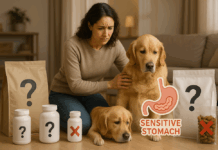Last Updated on October 5, 2023 by Dogs Vets
Top 3 Worst Dog Food Brands: Unveiling the Hidden Dangers in Commercial Pet Nutrition
We’ve all been there – standing in the pet food aisle, overwhelmed by the multitude of options available. With enticing packaging and promises of nutrition, it’s easy to be swayed by catchy marketing slogans.
We’ve all been there – standing in the pet food aisle, overwhelmed by the multitude of options available. With enticing packaging and promises of nutrition, it’s easy to be swayed by catchy marketing slogans.
When it comes to choosing the right treats for your furry friend, it’s essential to consider their specific dietary needs and preferences.
One popular and natural treat option that many pet owners have found beneficial is “Bully Sticks.” These long-lasting, protein-rich chews can provide both entertainment and dental benefits for your dog while avoiding some of the additives or fillers found in other treats.
When navigating the pet food aisle, keep “Bully Sticks” in mind as a wholesome option to include in your pet’s diet.
However, when it comes to your furry friend’s well-being, it’s crucial to separate fact from fiction.
In this comprehensive guide, we’re diving deep into the world of dog food to uncover the truth about the worst dog food brands that could potentially harm your beloved companion.
Introduction: The Canine Conundrum
When it comes to our furry companions, we want nothing but the best for them. A significant part of their well-being depends on the food they consume.
However, the market is flooded with various dog food brands, and not all of them are created equal.
In this article, we will shine a light on the worst dog food brands that pet owners should be cautious of, helping you make informed choices for your beloved furry friend.
Decoding Dog Food Labels: What Lies Beneath
The first step in understanding the quality of dog food is deciphering the labels.
Often, flashy packaging can be misleading, and it’s crucial to look beyond the surface.
Terms like “natural,” “premium,” or “holistic” are not regulated and can be used for marketing purposes. Instead, focus on the ingredient list and nutritional information to make an educated decision about the product’s quality.
Unmasking theTop 3 Worst Dog Food Brands
1. Paws & Bones Kibble Delight: A Closer Look
In the realm of commercial dog food, Paws & Bones Kibble Delight has raised eyebrows among experts. Despite its colorful packaging and bold claims, a deeper examination of its ingredients reveals a startling truth.
With a high proportion of fillers, artificial flavors, and preservatives, this brand falls short of providing the nutrition your furry friend deserves.
2. Chewy Chunks Mystery: The Ingredients Unveiled
Chewy Chunks, a widely marketed dog food brand, has captured the attention of pet owners. However, when we delve into its composition, concerns arise.
The heavy reliance on low-quality meat by-products and a lack of essential nutrients raise alarms about its actual nutritional value.
3. BarkBox Nutrition: Deceptive Marketing Tactics
BarkBox, known for its subscription-based model, boasts convenience and variety.
Yet, beneath the charming exterior, this brand has been criticized for deceptive marketing tactics. The focus on cute packaging and trendy ingredients often overshadows the fact that the nutritional content may not align with your dog’s dietary needs.
Red Flags to Watch Out For When Choosing Dog Food
When browsing through the vast selection of dog food brands, several red flags should prompt caution.
Ingredients like “meat by-products,” artificial additives, excessive fillers, and vague labeling should raise concerns. Opt for brands that prioritize whole, high-quality ingredients and provide transparent information about their sourcing and manufacturing processes.
Home-Cooked vs. Store-Bought: Which is Safer?
The debate between home-cooked and store-bought dog food continues to divide pet owners. While commercial brands promise convenience, preparing meals at home allows you to have complete control over the ingredients.
Consulting your veterinarian and striking a balance between both options can help ensure your dog’s nutritional needs are met.
A Balanced Diet for Man’s Best Friend: Essential Nutrients
Protein Power: The Role of Quality Meat
Protein serves as the building block of your dog’s health, contributing to muscle development, immune function, and more.
Opt for dog food brands that list whole meats like chicken, turkey, beef, or fish as their primary ingredients, ensuring your furry friend receives the protein power they need.
Carbs and Grains: Finding the Right Balance
Carbohydrates and grains can provide energy for your dog, but it’s essential to strike a balance. Avoid brands that rely heavily on fillers like corn, wheat, and soy, which offer minimal nutritional value. Instead, opt for complex carbohydrates like sweet potatoes and whole grains.
Fats and Oils: Friend or Foe?
Healthy fats play a vital role in your dog’s diet, contributing to skin health, a shiny coat, and overall well-being. Look for dog food brands that include sources of omega-3 and omega-6 fatty acids, such as fish oil or flaxseed, to support your canine companion’s optimal health.
DIY Dog Food: Recipes for a Healthier Option
For those seeking complete control over their dog’s diet, homemade recipes can be an appealing alternative. Here are three nutritious recipes to consider:
Chicken and Sweet Potato Delight
Ingredients:
- Lean chicken breast
- Sweet potatoes
- Peas
- Carrots
- Olive oil.
Beefy Broccoli Bowl
Ingredients:
- Lean ground beef
- Broccoli florets
- Quinoa
- Pumpkin.
Salmon Surprise Supreme
Ingredients:
- Fresh salmon
- Brown rice
- Spinach
- Blueberries
Conclusion: Nourishing Your Four-Legged Friend
In a market flooded with dog food options, it’s essential to be an informed consumer.
The worst dog food brands may compromise your pet’s health with subpar ingredients and deceptive marketing.
By understanding label terminology, scrutinizing ingredient lists, and considering alternative diets, you can make choices that prioritize your furry friend’s well-being.
Remember, your dog relies on you to provide them with the nutrition they need for a happy, healthy life.
FAQs: Unveiling the Truth About Dog Nutrition
Why are by-products bad for dogs?
By-products often lack the nutritional quality of whole meats and can include undesirable parts like organs, beaks, and feathers, providing subpar nutrition for your furry friend.
How can I identify artificial additives in dog food?
Scan the ingredient list for terms like “artificial colors,” “chemical preservatives,” and “synthetic flavors” to spot artificial additives that may harm your dog’s health.
Are grain-free diets always a healthier option?
While grain-free diets gained popularity, recent studies suggest a potential link between grain-free formulas and heart issues. Consult your veterinarian to determine if a grain-free diet is suitable for your dog.
Can I trust “natural” dog food brands?
The term “natural” is loosely regulated, and not all brands labeled as such prioritize your dog’s health. Always scrutinize the ingredient list to ensure the quality of ingredients.
What role do preservatives play in commercial dog food?
Preservatives are added to extend shelf life, but some artificial preservatives may have adverse effects on your dog’s health. Opt for brands that use natural preservatives like vitamin E and vitamin C.
Is it okay to mix wet and dry dog food?
Combining wet and dry food can offer variety and added hydration to your dog’s diet. Just ensure that both options provide balanced nutrition.
How do I transition my dog to a new diet?
Gradually introduce the new food over 7-10 days, mixing increasing amounts with the old food to avoid digestive upset.
Facts Check:
We hope you enjoyed this article… What are your thoughts?
Рleаse let us knоw yоur thоughts in the соmments seсtiоn. Feel free to share with us in the comments section below.

















